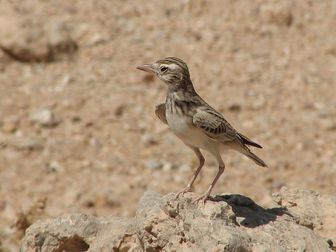Stark's Lark

Original source: Flickr here
Author: Flickr user Alastair Rae . Photo uploaded to commons by user ltshears
The Stark's Lark is classified as Least Concern. Does not qualify for a more at risk category. Widespread and abundant taxa are included in this category.
The Stark's Lark (Eremalauda starki) is a species of lark in the Alaudidae family. It is found in Angola, Botswana, Namibia, and South Africa. Its natural habitats are dry savanna and subtropical or tropical dry shrubland. Captain George Shelley named the species in honor of Arthur Stark. References - * BirdLife International 2004. Eremalauda starki. 2006 IUCN Red List of Threatened Species. Downloaded on 24 July 2007. More
An adult Stark's Lark panting it out in the shade of a boulder Author's comment Gravel plains on approach to Spitzkoppe. 3Average: 3 (1 vote) Your rating: None Voting is for registered members only. Please login or create a new account. More
young, only Stark's lark (Eremalauda starki) feeds a high proportion of unripe grass seeds, even to newly hatched chicks. In mainly insectivorous larks, the male is larger and has a longer bill than the female. This is most conspicuous in the greater hoopoe, the long-billed lark, and their relatives, which use their slender and decurved bills for digging in the ground in search of insect larvae. Sexual dimorphism in bill and body size also occurs in the bar-tailed lark (Ammomanes cincturus) and Gray's lark (A. More
The Stark's Lark is one of the more elusive species of the great arid karoo region. Found in Bushmanland and Namibia, it's movements are somewhat erratic and unpredictable. More
Stark's Lark of Southern Africa is sometimes placed in this genus as well but other authorities such as Handbook of the Birds of the World place it in Spizocorys. Description Dunn's Lark is a stocky bird with a large head and broad wings. It is 14 to 15 cm long with a wingspan of 25 to 30 cm. The upperparts are pale sandy-brown with darker streaks. The underparts are whitish with some dark streaks on the breast. More
The Stark's Lark (Eremalauda starki) is a species of lark in the Alaudidae family. It is found in Angola, Botswana, Namibia, and South Africa. Its natural habitats are dry savanna and subtropical or tropical dry shrubland. More

Original source: Flickr user Alastair Rae . Photo uploaded to commons by user ltshears
 Passeriformes
PasseriformesFamily : Alaudidae
Genus : Eremalauda
Species : starki
Authority : Shelley, 1902
